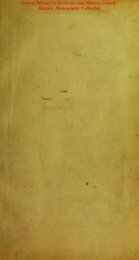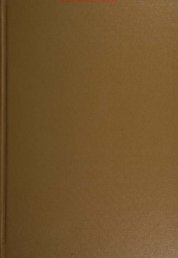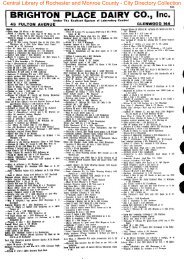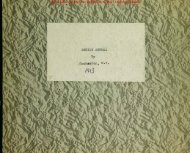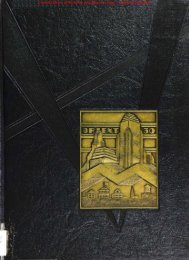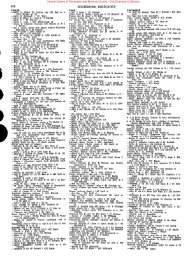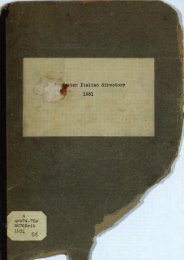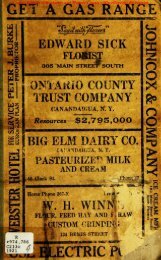The Farm Journal Illustrated Rural Directory of Monroe County, New ...
The Farm Journal Illustrated Rural Directory of Monroe County, New ...
The Farm Journal Illustrated Rural Directory of Monroe County, New ...
Create successful ePaper yourself
Turn your PDF publications into a flip-book with our unique Google optimized e-Paper software.
Central Library <strong>of</strong> Rochester and <strong>Monroe</strong> <strong>County</strong> · <strong>County</strong> Directories Collection<br />
CLASSIFIED BUSINESS DIRECTORY<br />
Concrete<br />
Concrete is made by mixing together<br />
Portland cement, sand and stone (or<br />
gravel). Various proportions <strong>of</strong> each<br />
are used, depending upon the use to<br />
which the concrete is put. About half<br />
an hour after mixing these materials<br />
together, the mass begins to stiffen,<br />
until, in from half a day to a day, it becomes<br />
so hard that you cannot dent it<br />
with the hand. By a month the mass<br />
is hard as stone—indeed, harder than<br />
most stones. <strong>The</strong> be/t way to buy<br />
cement is in cloth sacks. Manufacturers<br />
charge more for cement in cloth sacks,<br />
but allow a rebate for the return <strong>of</strong><br />
the empty sacks. A bag <strong>of</strong> cement<br />
weighs 95 pounds, and four such bags<br />
make a barrel <strong>of</strong> 380 pounds.<br />
It is important that your stock <strong>of</strong><br />
cement be kept in a dry place. Once<br />
wet, it becomes hard and lumpy, and<br />
in such condition is useless. If, however,<br />
the lumps are caused by pressure<br />
in the storehouse, the cement may be<br />
used with safety. Lumps thus formed<br />
can be easily broken by a blow from<br />
the back <strong>of</strong> a shovel.<br />
In storing cement, throw wooden<br />
blocks on the floor. Place boards over<br />
them and pile the cement on the boards,<br />
covering the pile with a canvas or a<br />
piece <strong>of</strong> ro<strong>of</strong>ing paper. Never, under<br />
any circumstances, keep cement on the<br />
bare ground, or pile it directly against<br />
the outside walls <strong>of</strong> the building.<br />
Do not use very fine sand. If there<br />
is a large quantity <strong>of</strong> fine sand handy,<br />
obtain a coarse sand and mix the two<br />
sands together in equal parts; this mixture<br />
is as good as coarse sand alone.<br />
Sometimes fine sand must be used, because<br />
no other can be obtained; but<br />
in such an event an additional amount<br />
<strong>of</strong> cement must be used—sometimes as<br />
much as double the amount ordinarily<br />
required. For example, in such a case,<br />
instead »f using a concrete 1 part cement,<br />
2J4 parts sand and 5 parts stone,<br />
use a concrete 1 part cement, 1% parts<br />
sand and 2J4 parts stone.<br />
Besides being coarse, the sand should<br />
be clean. <strong>The</strong> presence <strong>of</strong> dirt in the<br />
sand is easily ascertained by rubbing a<br />
little in the palm <strong>of</strong> the hand. If a<br />
little is emptied into a pail <strong>of</strong> water,<br />
the presence <strong>of</strong> dirt will be shown by<br />
the discoloration <strong>of</strong> the water. This<br />
can be discovered also by filling a fruit<br />
jar to the depth <strong>of</strong> 4 inches with sand<br />
M then adding water until it is within<br />
an inch <strong>of</strong> the top. After the jar has<br />
been well shaken, the contents should be<br />
allowed to settle for a couple <strong>of</strong> hours.<br />
<strong>The</strong> sand will sink to the bottom, but<br />
the mud, which can be easily recognized<br />
by its color, will form a distinct layer<br />
on top <strong>of</strong> the sand, and above both will<br />
be a clear depth <strong>of</strong> water. If the layer<br />
<strong>of</strong> mud is more than one-half inch in<br />
thickness, the sand should not be used<br />
unless it is first washed.<br />
To wash sand build a loose board<br />
platform from 10 to IS feet long, with<br />
one end a foot higher than the other.<br />
On the lower end and on the sides<br />
nail a board 2 by 6 inches on edge to<br />
hold the sand. Spread the sand over<br />
this platform in a layer three or four<br />
inches thick, and wash it with a hose.<br />
<strong>The</strong> washing should be started at the<br />
high end and the water allowed to run<br />
through the sand and over the 2-by-6-<br />
381<br />
inch piece at the bottom. A small<br />
quantity <strong>of</strong> clay or loam does not injure<br />
the sand, but any amount over 5 per<br />
cent. does.<br />
Great care should be used in the<br />
selection <strong>of</strong> the stone or gravel. <strong>The</strong><br />
pebbles should be closely inspected to<br />
see that there is no sclay on their surface.<br />
A layer <strong>of</strong> such clay prevents<br />
the "binding^ <strong>of</strong> the cement. If necessary,<br />
stone or gravel may be washed<br />
in the same way as above described<br />
for sand. Dust may be left in the<br />
crushed stone without fear <strong>of</strong> its interfering<br />
with the strength <strong>of</strong> the cement,<br />
but care should be taken to see that'<br />
such dust is distributed evenly through<br />
the whole mass, and when dust is found<br />
in stone, slightly less sand should be<br />
used than ordinarily. As to the si;«<br />
<strong>of</strong> stone or gravel, this must be determined<br />
by the form <strong>of</strong> construction<br />
contemplated. For foundations or any<br />
large thick structure, use anything from<br />
y 2 to 2Y2. inches in diameter. For thir:<br />
walls use J4 *° 1-inch stone. <strong>The</strong> best<br />
results are obtained by the use <strong>of</strong> a<br />
mixture <strong>of</strong> sizes graded from small to<br />
large. By this means the spaces between<br />
the stones or pebbles are reduced<br />
and a more compact concrete is obtained.<br />
Moreover, this method makes<br />
it possible to get along with less sand<br />
and less cement.<br />
Water for concrete should be clean<br />
and free from strong acids and alkalies.<br />
It may be readily stored in a barrel



